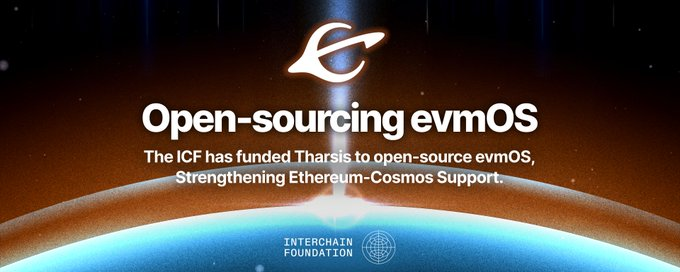Event Background and Core Developments
Recently, the Interchain Foundation (ICF) announced that Evmos has been officially integrated into the Cosmos SDK as the native EVM framework, marking the first standardized Ethereum Virtual Machine (EVM) compatibility within the Cosmos ecosystem. In this integration, the Evmos codebase has been renamed “Cosmos EVM” and incorporated into the official cross‑chain protocol stack, covering more than 200 application chains within the Cosmos ecosystem. This move aims to break down the ecological barriers between Ethereum and Cosmos, promoting seamless cross‑chain interaction of assets and smart contracts.
Originally developed by Tharsis Labs, Evmos served as a bridge connecting the Cosmos IBC protocol and the Ethereum ecosystem, supporting cross‑chain circulation of ERC‑20 tokens and MetaMask wallet integration. After this upgrade, developers can deploy Ethereum‑compatible blockchains directly via the Cosmos SDK and use the IBC protocol to achieve multi‑chain communication, greatly reducing the cost of cross‑chain development.

Technical Breakthrough: Modular Design and Enhanced Developer Experience
The integration of Cosmos EVM is not a simple code port; it is a systematic upgrade based on a modular architecture. The new framework allows developers to build smart contracts on Cosmos that are fully compatible with Ethereum while retaining the high‑performance characteristics of the Tendermint consensus engine. For example, developers can customize gas fee rules or introduce a privacy layer without modifying the underlying consensus mechanism. This flexibility enables Cosmos EVM to combine the mature toolchain of the Ethereum ecosystem with Cosmos’ cross‑chain scalability.
For Ethereum developers, this integration means a lower migration threshold. Cosmos EVM supports Ethereum standard tools (such as Hardhat and Truffle) and provides native compatibility with wallets like MetaMask. Through the IBC protocol, Ethereum DApps can directly interact with assets and contracts on Cosmos chains—for example, trading Osmosis liquidity pool tokens on Uniswap or using Cosmos ecosystem’s ATOM assets as collateral on Aave. This interoperability opens up new sources of liquidity for DeFi, NFT, and RWA (Real‑World Asset tokenization) protocols.
Market Impact: Ecosystem Expansion and Competitive Landscape Reshaping
The launch of Cosmos EVM could trigger a reconfiguration of the multi‑chain ecosystem.
- First, Ethereum developers can seamlessly migrate to Cosmos, taking advantage of its high throughput (with measured TPS reaching 10,000) and low gas costs (approximately $0.001), thereby optimizing the user experience.
- Second, cross‑chain liquidity will be further consolidated—Cosmos’ current total value locked (TVL) is about $18 billion, and with EVM compatibility, it can attract DeFi funds from Ethereum, forming a virtuous cycle. For example, the decentralized exchange Osmosis has already planned to launch EVM‑based derivative trading pairs.
- Moreover, Cosmos EVM may pose competitive pressure on independent EVM chains such as Avalanche and Polygon. Compared to these chains, Cosmos’ differentiated advantage lies in its modular architecture and mature cross‑chain communication protocol (IBC). In the future, enterprise‑level users might prefer the customizable and highly interconnected Cosmos EVM over a single, relatively fixed EVM chain.
Potential Challenges: Technical Risks and Ecosystem Governance
Despite its promising prospects, the integration of Cosmos EVM still faces multiple challenges.
- On the technical front, cross‑chain interactions may introduce new attack surfaces—for example, interactions between the IBC protocol and EVM smart contracts need safeguards against reentrancy attacks or oracle manipulation risks.
- In addition, existing Cosmos chains (such as Injective and Cronos) will need to gradually adapt to the new framework, and compatibility issues during migration may lead to short‑term ecosystem fragmentation.
- Community governance is another critical issue. The inflation model and unlimited supply mechanism of the Evmos token (EVMOS) have previously sparked controversy; after the integration, balancing the token economy to maintain developer incentives will be necessary.
- Meanwhile, governance of the Cosmos Hub still remains concentrated among the top validators, so the decentralization process needs further transparency to avoid excessive power concentration that might hinder ecosystem innovation.
Future Outlook: Full‑Chain Interoperability and Compliance Exploration
The long‑term goal of Cosmos EVM is not only to connect with Ethereum but to become the core of a full‑industry interoperability protocol. The Interchain Foundation plans to launch an “EVM as a Service” module in Q4 2025, allowing non‑technical teams to quickly deploy customized EVM chains through parameter configuration. This initiative will upgrade Cosmos from a “blockchain internet” to a “multi‑chain financial operating system,” covering diverse scenarios such as DeFi, gaming, and social networking.
Compliance is another key focus. Cosmos EVM plans to integrate on‑chain KYC tools and support the issuance of compliant stablecoins and security tokens. For instance, institutional users could complete identity verification through JuCoin and then issue assets on Cosmos that comply with the EU MiCA regulations. Such innovations might attract traditional financial institutions, accelerating the integration of Web3 with mainstream finance.
The integration of Cosmos EVM is not merely a technical upgrade but a milestone in the collaborative evolution of the multi‑chain ecosystem. As the developer ecosystem of Ethereum and the cross‑chain capabilities of Cosmos deeply integrate, a more open and interconnected blockchain world is rapidly approaching.




